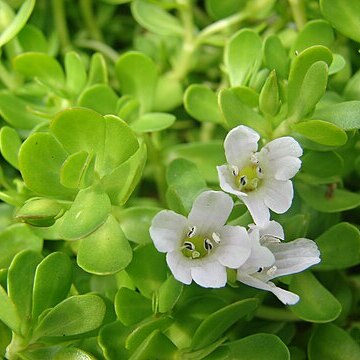Sep 5 (in our spp.), distinct, imbricate, the upper median one about twice as wide as the 2 lower and 4 times as wide as the lateral ones; cor tubular or campanulate to salverform, in our spp. virtually regular or with the 2 upper lobes connate half-length; stamens (2–)4, inserted below the middle of the cor-tube; pollen-sacs parallel; stigmas 2 and distinct or one and bilobed; fr globose, septicidal and/or loculicidal; small perennial herbs of wet shores or shallow water, with sessile, opposite, entire or toothed lvs and small, white or blue fls borne singly or in pairs in the lf-axils. 100, warm reg.
Herbs, erect or creeping. Leaves opposite. Flowers solitary, axillary or in terminal racemes. Bracteoles 1 or 2 or absent. Sepals (4 or)5, entirely free, imbricate, upper 1 largest, lower 2 next large, lateral 2 innermost and narrowest. Corolla tube tubular; limb patent, conspicuously or obscurely 2-lipped; lower lip 3-lobed; upper lip 2-lobed. Stamens 4, didynamous or equal in length, very rarely 5; anther locules parallel, free. Stigma dilated, capitate or 2-lobed. Capsule ovoid or globose, 2-grooved, 4-valved. Seeds numerous, minute.
Leaves opposite, entire or variously dentate to crenate, or capillary-divided in aquatic species.
Calyx 5-partite; sepals imbricate, posterior broadest, lateral usually very narrow.
Flowers axillary, solitary, pedicellate or sessile, bracteate or ebracteate.
Annual herbs, erect, prostrate or decumbent, or floating, mostly glabrous.
Corolla bilabiate, upper lip bilobed or emarginate, lower trilobed.
Capsule ovoid to globose, 2 or 4 loculicidal or septicidal.
Stamens four, didynamous, perfect, included.
Style apically dilated, entire or bilobed.
Seeds small, numerous.
Ovules many.

